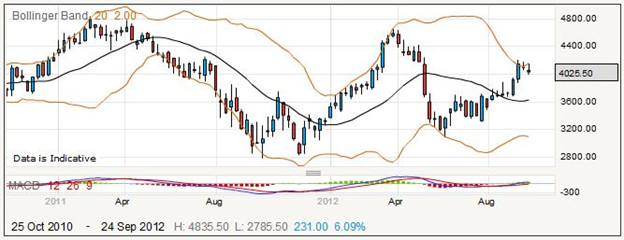J.P. Morgan Chase is an international company dealing in a variety of financial services in over 50 countries. Therefore, if you are considering spread betting on its share price, there are many different aspects to take into account. Considered on the basis of its assets, JPMC is the largest bank in the US, overtaking the Bank of America in October 2011, according to Bloomberg.
Almost inevitably for the financial sector, you should know that the shares went through a massive loss in price in 2008, but it wasn’t as bad as some. The high prior to the global crash was about 5300, and the lowest point was around 1500. It is currently up trading around 4000, as you can see from this monthly price chart.

What you will also notice is that the share price has been significantly volatile over the past couple of years, which can be an advantage for you as a spread trader, providing profit opportunities when you can correctly predict the market. The MACD provides some clues above, but does not appear to be a great predictor.
The company has been formed from amalgamations and mergers of many different financial institutions. The earliest constituent institution that can be traced is the Bank of Manhattan Company, founded in 1799. Another early company was the Chemical Bank of New York in 1824. Chemical Bank has often been the largest bank in America over the years, but in 1996 it bought the Chase Manhattan Corporation, taking on the better known name. JP Morgan came into the fold in 2000, making J.P. Morgan Chase, although the headquarters are still the old Chemical Bank headquarters in Park Avenue.
In recent years the share price has obviously been affected by the global economy and news and rumour about delinquent debts, which makes the shares interesting though risky to trade. Given the size of the Chase credit card operation, there are alternative sides to the business, away from collateralized considerations, and this is perhaps why the value has been sustained better than some other financial institutions.
JP Morgan Chase Rolling Daily Spreadbet
The shares of J.P. Morgan Chase have volatile pricing, and you must take care to not overstretch your resources in case there is bad news which suddenly affects the value. The current price for a rolling daily bet is 4020 – 4029. Therefore, if you think that the share price is going up you could place a spread bet for £2 per point at the buying price of 4029.
Given the volatility of the shares, you might well find that in a week or two the price has gone up to 4526 – 4535. If you close the spread bet and cash in then, you can figure out that you have gained 4526 minus 4029 points, which is 497 points. This would give you a gain of 497 times £2 or £994. In addition, your account may be charged a small amount each evening that the bet is automatically rolled over.
But the price might go down instead, and then you would be facing a loss. One of the secrets of successful trading is to minimize your losses by closing your bets as soon as you realize they’re not working. Perhaps you would close this bet when the price goes down to 3786 – 3795. This time you have lost the difference in points, which is 4029 less 3786, 243 points. At £2 per point, you would lose £486.
If you are like most spread traders, and cannot guarantee that you will be watching the market constantly, then you may wish to place a stop loss order to tell your spread betting company to close the bet at a certain level of loss. With a stoploss order, you might find that your losing trade was closed earlier, perhaps when the price was 3854 – 3863. Working this loss out, the loss in points is 4029-3854, which is 175 points. For your chosen size of stake, this comes out to £350.
JP Morgan Chase Futures Spread Betting
With a futures style spread bet, you do not incur any ongoing charges while the bet is open. However, you usually pay a larger spread, so you only want to use a futures style bet if you expect to hold the bet for some time. The current price for the far quarter, currently nine months away from expiration, is 4028 – 4061. Perhaps you take a bearish view of this stock, and are prepared to stake £1.50 per point on a short or sell bet. The bet would be placed at the selling price of 4028.
Assume that your bet works out, the price falls to 3621 – 3652, and you decide to collect your winnings. With a starting price of 4028 and a closing price of 3652, your sell bet has made 376 points. For the size of stake that you chose, this would win you £564.
If the price goes the wrong way, you may be faced with the need to close the bet and accept your loss. Although this is hard to do, it is often better than waiting on in hope for it to turn around, and meanwhile building up a larger and larger loss. Perhaps you would decide to close your bet when it reached 4369 – 4397. The entry price was 4028, and the buying price when you exited was 4397. This is a difference of 369 points, and that would cost you £553.50.
Many times a better way to exit a losing bet is to use a stop loss order. The advantages are that you do not have to be watching the market at the time, and the bet is closed without an emotional wrangle. In this case a stoploss order might have closed your bet when it went up to 4287 – 4318. The difference between 4318 and 4028 is 290 points, therefore this time you would have lost £435.